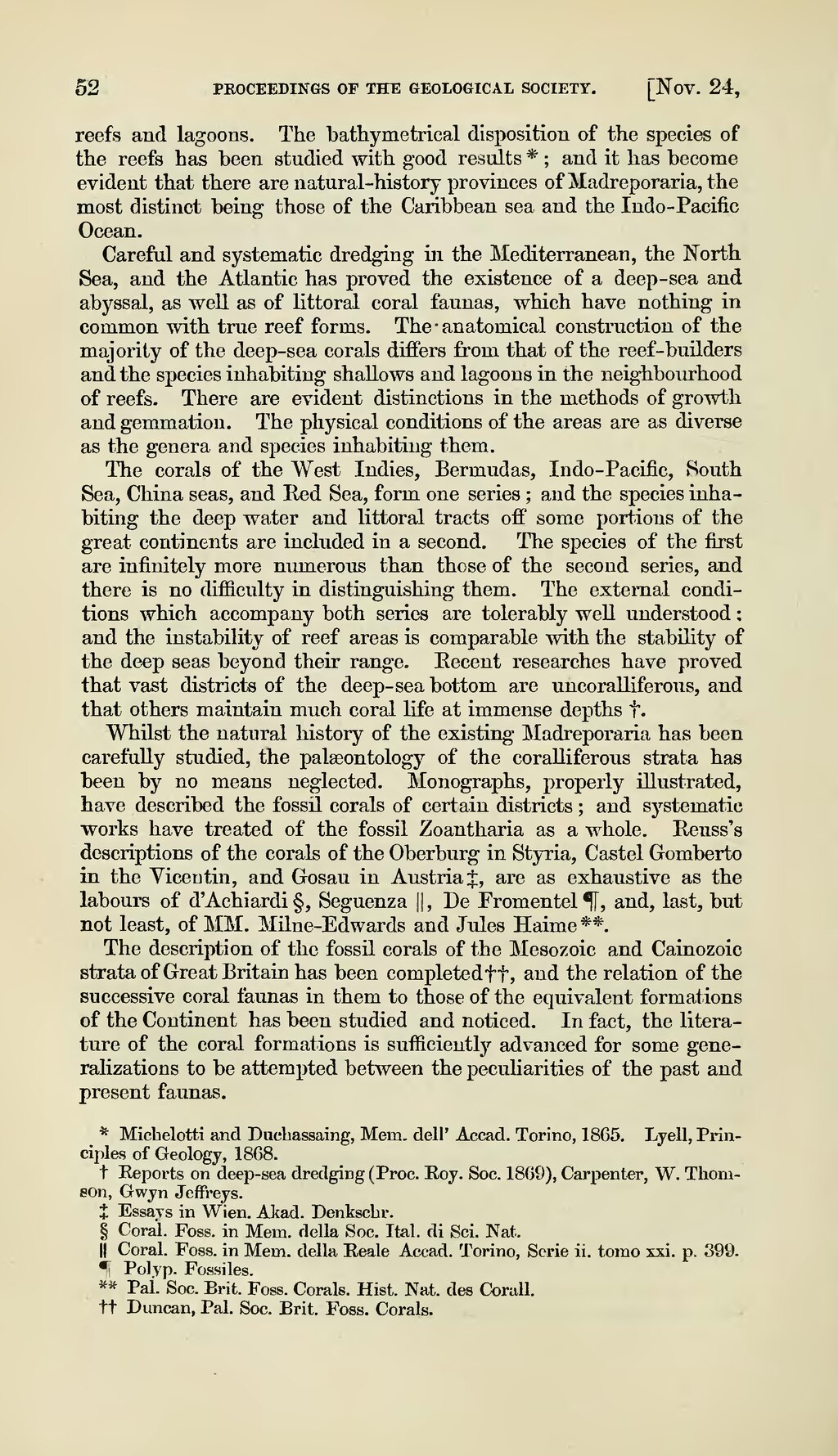52 PROCEEDINGS OF THE GEOLOGICAL SOCIETY. [Nov. 24,
reefs and lagoons. The bathymetrical disposition of the species of
the reefs has been studied with good results*; and it has become
evident that there are natural-history provinces of Madreporaria, the
most distinct being those of the Caribbean sea and the Indo-Pacific
Ocean.
Careful and systematic dredging in the Mediterranean, the North Sea, and the Atlantic has proved the existence of a deep-sea and abyssal, as well as of littoral coral faunas, which have nothing in common with true reef forms. The anatomical construction of the majority of the deep-sea corals differs from that of the reef-builders and the species inhabiting shallows and lagoons in the neighbourhood of reefs. There are evident distinctions in the methods of growth and gemmation. The physical conditions of the areas are as diverse as the genera and species inhabiting them.
The corals of the West Indies, Bermudas, Indo-Pacific, South Sea, China seas, and Red Sea, form one series; and the species inhabiting the deep water and littoral tracts off some portions of the great continents are included in a second. The species of the first are infinitely more numerous than those of the second series, and there is no difficulty in distinguishing them. The external conditions which accompany both series are tolerably well understood; and the instability of reef areas is comparable with the stability of the deep seas beyond their range. Recent researches have proved that vast districts of the deep-sea bottom are uncoralliferous, and that others maintain much coral life at immense depths†.
Whilst the natural history of the existing Madreporaria has been carefully studied, the palaeontology of the coralliferous strata has been by no means neglected. Monographs, properly illustrated, have described the fossil corals of certain districts; and systematic works have treated of the fossil Zoantharia as a whole. Reuss's descriptions of the corals of the Oberburg in Styria, Castel Gomberto in the Vicentin, and Gosau in Austria‡, are as exhaustive as the labours of d'Achiardi§, Seguenza||, De Fromentel¶, and, last, but not least, of MM. Milne-Edwards and Jules Haime**.
The description of the fossil corals of the Mesozoic and Cainozoic strata of Great Britain has been completed††, and the relation of the successive coral faunas in them to those of the equivalent formations of the Continent has been studied and noticed. In fact, the literature of the coral formations is sufficiently advanced for some generalizations to be attempted between the peculiarities of the past and present faunas.
- Michelotti and Duchassaing, Mem. dell' Accad. Torino, 1865. Lyell, Principles
of Geology, 1868.
† Reports on deep-sea dredging (Proc. Roy. Soc. 1869), Carpenter, W. Thomson, Gwyn Jeffreys.
‡ Essays in Wien. Akad. Denkschr.
§ Coral. Foss. in Mem. della Soc. Ital. di Sci. Nat.
|| Coral. Foss. in Mem. della Reale Accad. Torino, Serie ii. tomo xxi. p. 399.
¶ Polyp. Fossiles.
- Pal. Soc. Brit. Foss. Corals. Hist. Nat. des Corall.
†† Duncan, Pal. Soc. Brit. Foss. Corals.

